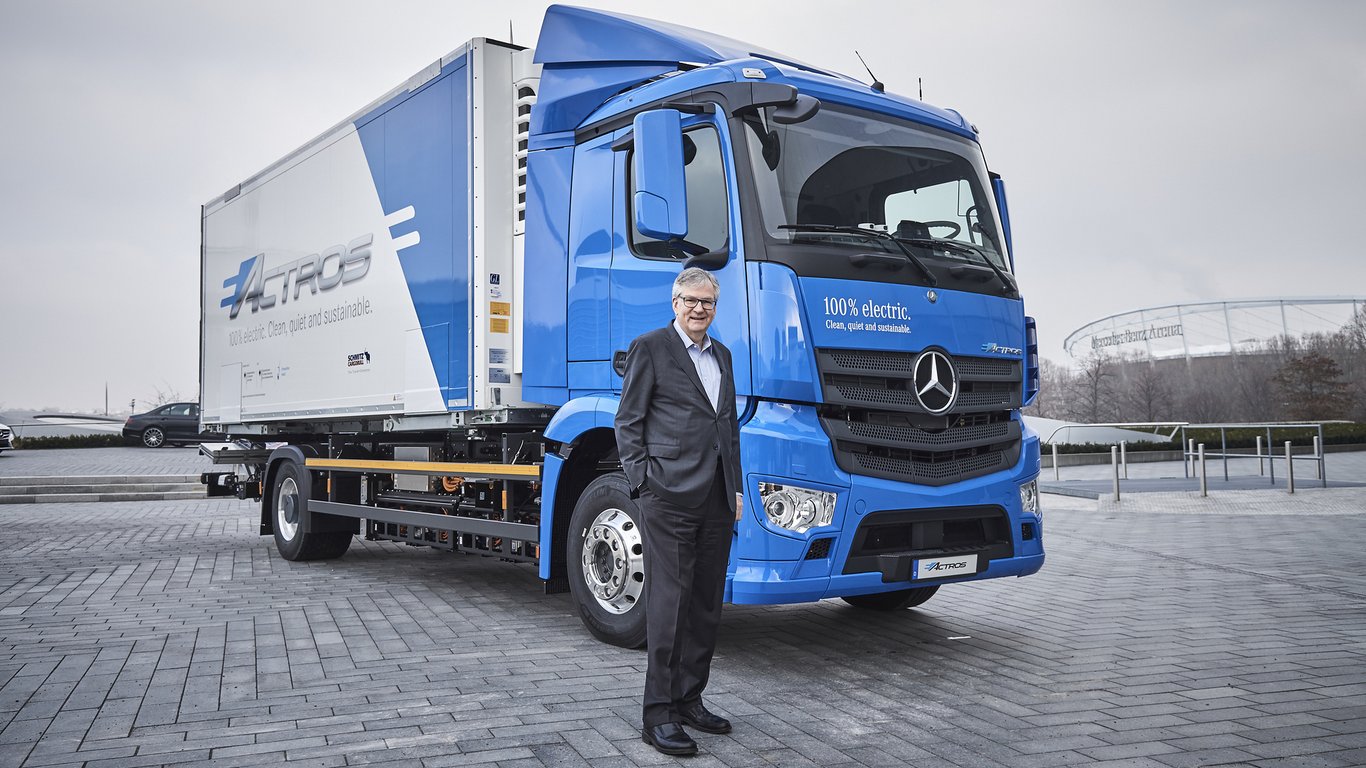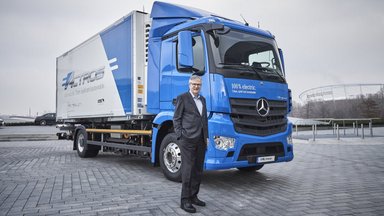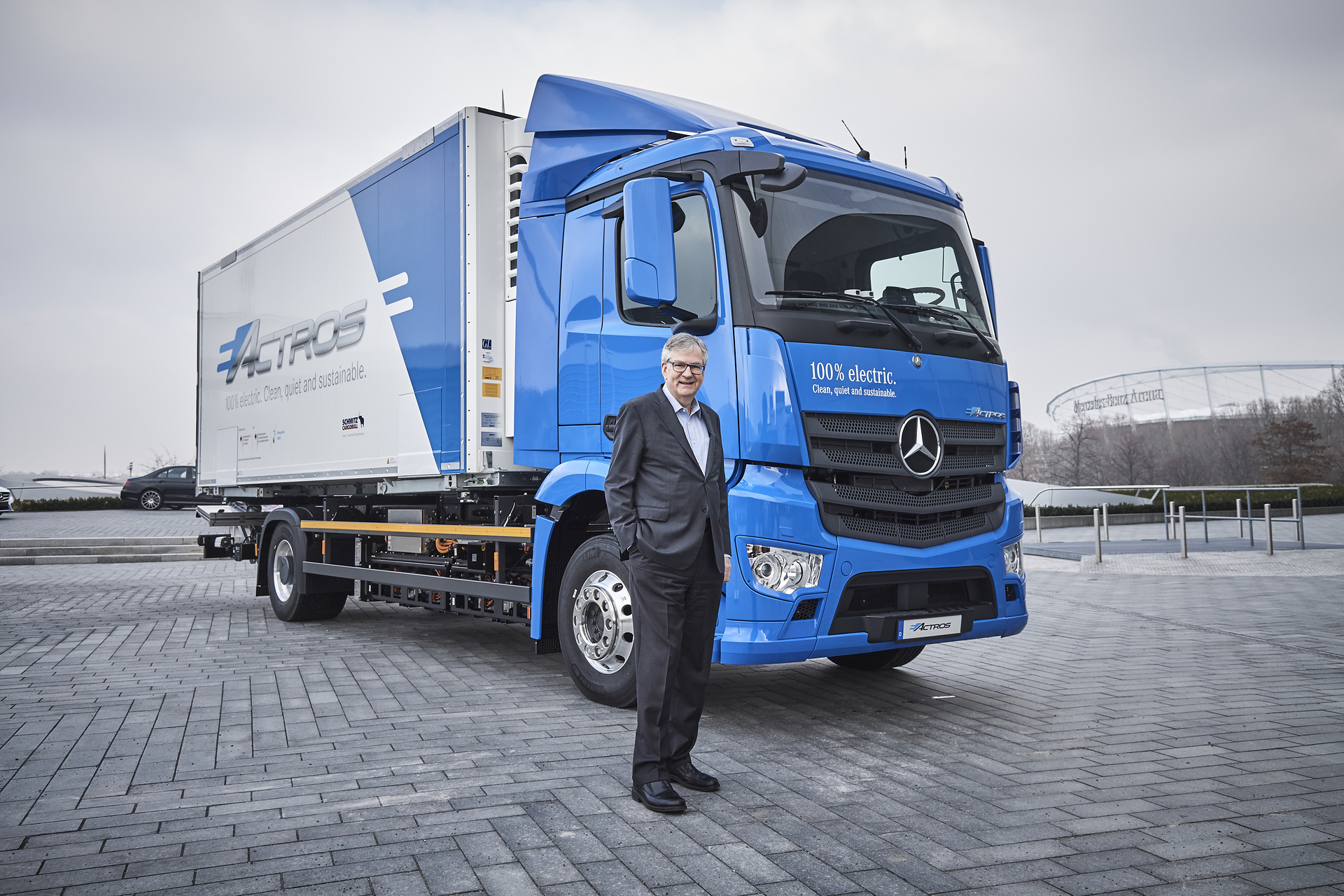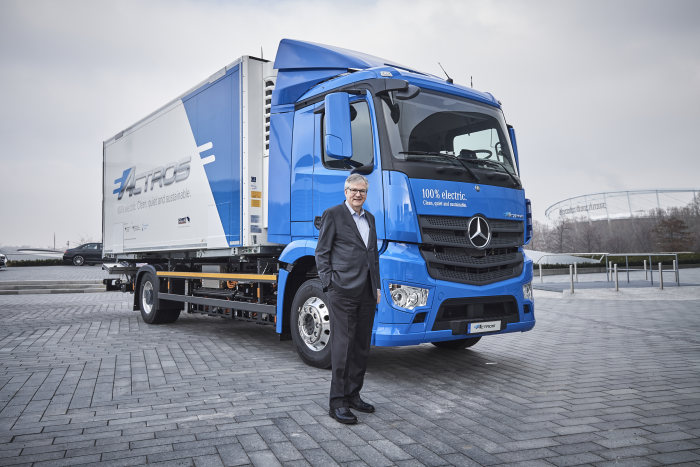
Daimler’s truck division: Good prospects for 2018 – unit sales and earnings expected to be significantly higher than in good prior year
Download

Daimler’s truck division: Good prospects for 2018 – unit sales and earnings expected to be significantly higher than in good prior year
Clear growth in unit sales, revenue and EBIT in 2017 – unit sales and earnings expected to be significantly higher than in prior year also in 2018 Investment in technology leadership: €500 million for research and development in electric mobility, connectivity and automated driving for trucks Sustainable, fully electric and quiet: heavy-duty Mercedes-Benz eActros electric truck in use by customers in 2018 Martin…
- Clear growth in unit sales, revenue and EBIT in 2017 – unit sales and earnings expected to be significantly higher than in prior year also in 2018
- Investment in technology leadership: €500 million for research and development in electric mobility, connectivity and automated driving for trucks
- Sustainable, fully electric and quiet: heavy-duty Mercedes-Benz eActros electric truck in use by customers in 2018
- Martin Daum: “In everything we do, we focus on our customers. In order to offer them the best products and services, we are continually investing in innovations. This will bring us sustained success also in 2018 – the year of the Commercial Vehicles Show in Germany – and beyond.”
Stuttgart – Significant growth in unit sales, revenue and EBIT: 2017 was a very successful year for Daimler Trucks – despite a modest start to the year and little tailwind from the relevant markets. Daimler’s truck division increased its unit sales by 13 percent to 470,700 vehicles in 2017 (2016: 415,100). Revenue of €35.7 billion was also significantly higher than the prior-year figure (2016: €33.2 billion). The division’s EBIT in 2017 of €2,380 million was 22 percent above the prior-year result of €1,948 million and its return on sales was 6.7 percent (2016: 5.9 percent).
“In 2017, we clearly increased our unit sales, revenue and earnings compared with the previous year. The results were significantly better than we had expected at the beginning of the year. That’s only possible with leading products and an outstanding international team,” stated Martin Daum, Member of the Board of Management of Daimler AG responsible for Trucks & Buses. “We work systematically on our products and our productivity. We therefore assume that we will once again achieve total unit sales and EBIT significantly above the good prior-year levels.”
Daum continued: “We naturally rely not only on growing markets. We work systematically on the implementation of our long-term strategy. In everything we do, we focus on our customers. In order to offer them the best products and services, we are continually investing in innovations. This will bring us sustained success also in 2018 – the year of the Commercial Vehicles Show in Germany – and beyond.”
Investment in the future: half a billion euros for research and development in the technology fields “automated”, “ connected” and “electric”
In 2018 and 2019, Daimler Trucks will invest approximately €1.3 billion on average each year in research and development. As the areas of electric mobility, connectivity and automated driving are steadily becoming more important also in the truck business, approximately €500 million of that total spending in that period will flow into research and development in those technology areas. In addition, Daimler Trucks will of course also profit from the developments and expertise within the Group, for example in battery technology, assistance and safety systems, and automated driving.
Electric mobility at Daimler Trucks: the eActros follows the eCanter
Daimler Trucks is already leading in the electrification of commercial vehicles: The FUSO eCanter light-duty truck is the world`s first fully electric truck from series production. The Daimler subsidiary Mitsubishi Fuso Truck and Bus Corporation (MFTBC) has already delivered the first of these vehicles to selected customers in the United States, Europe and Japan.
With the eActros, Mercedes-Benz is now putting its electric truck into customers’ hands and onto the roads. In the coming weeks, ten vehicles in two versions with 18 and 25 tons gross vehicle weight will be delivered to customers, who will test their everyday usability and economy under real conditions. The goal is to achieve series and market maturity early in the next decade for economically competitive electric trucks in heavy-duty urban distribution transport.
Pioneering work: automated and connected driving from Mercedes-Benz, Freightliner and FUSO
With its truck brands Mercedes-Benz, Freightliner and FUSO, Daimler Trucks has been doing pioneering work in the fields of automated and connected driving for many years. Worldwide, Daimler Trucks has now connected more than half a million trucks with the Internet of things.
As early as April 2016, three connected and autonomously driving Mercedes-Benz Actros trucks drove from Stuttgart to Rotterdam as part of the European Truck Platooning Challenge. With truck platooning, connectivity and automated driving enhance the safety of vehicles driving in a convoy, make the driver’s job easier and improve fuel efficiency as a result of smaller gaps between the trucks. In a so-far unique test in the fall of 2017, Daimler Trucks presented another solution for the future use of trucks driving in automated mode: On an airfield, four Mercedes-Benz Arocs semitrailer tractors carried out the automated cleaning of the airfield in conjunction with each other and by remote control.
In the United States, Daimler is the first truck manufacturer to test the use of digitally connected trucks – so-called platooning – on public roads. As of 2018, Daimler Trucks North America will test digitally connected trucks in real-life transport together with large fleet customers.
Daimler Trucks is testing connected trucks also with its Asian brand, FUSO. A FUSO Super Great heavy-duty truck has driven in electronically connected and partially automated mode in a platoon with trucks from other Japanese manufacturers. The platooning test was initiated by two Japanese ministries and is part of the Japanese government’s Future Strategy 2017.
Daimler Trucks overview
|
| 2017 | 2016 |
| Revenue | 35,707 | 33,187 |
| EBIT | 2,380 | 1,948 |
| Investment in property, plant and equipment | 1,028 | 1,243 |
| Research and development expenditure | 1,322 | 1,265 |
| thereof: capitalized development costs | 45 | 57 |
In millions of euros (€)
| Employees (December 31) | 2017 | 2016 |
| Total | 79,483 | 78,642 |
| Germany | 30,424 | 31,405 |
| United States | 15,002 | 13,823 |
| Other countries | 34,057 | 33,414 |
| Unit sales | 2017 | 2016 |
| Total | 470,700 | 415,100 |
| EU30* | 82,300 | 79,800 |
| thereof: Germany | 31,700 | 31,500 |
| United Kingdom | 9,100 | 8,100 |
| France | 8,200 | 8,000 |
| NAFTA region | 165,000 | 145,700 |
| thereof: United States | 140,200 | 121,600 |
| Latin America (excluding Mexico) | 30,500 | 27,500 |
| thereof: Brazil | 13,400 | 12,100 |
| Asia | 148,600 | 125,400 |
| thereof: Japan | 44,800 | 46,400 |
| Indonesia | 42,700 | 28,000 |
| Additional information: | ||
| BFDA (Auman Trucks) | 112,400 | 77,800 |
| Total (including BFDA) | 583,100 | 492,900 |
*European Union, Switzerland, Norway
Article assets

Daimler’s truck division: Good prospects for 2018 – unit sales and earnings expected to be significantly higher than in good prior year

Daimler’s truck division: Good prospects for 2018 – unit sales and earnings expected to be significantly higher than in good prior year

Daimler’s truck division: Good prospects for 2018 – unit sales and earnings expected to be significantly higher than in good prior year

Daimler’s truck division: Good prospects for 2018 – unit sales and earnings expected to be significantly higher than in good prior year

Arnd Minne
Spokesperson Corporate Communications Mercedes-Benz Trucks & Daimler Buses
arnd.minne@daimlertruck.com
+49 176 30912514






